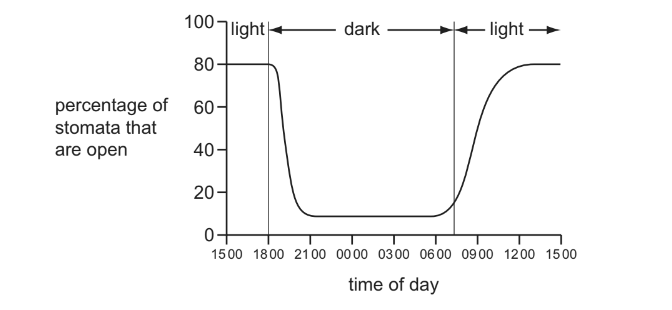Question
The diagram shows a model to demonstrate the mass flow hypothesis of translocation.

In a plant, what are the structures W, X, Y and Z and what is the direction of flow of solution along
W?

Answer/Explanation
Answer B
Question
The graph shows stomatal opening and closing in the leaves of a species of Pelargonium, during
a 24 hour period.

What can be concluded?
A Gas exchange occurs when stomata are open.
B Stomata open as light intensity increases.
C Stomata open as temperature increases.
D Transpiration does not occur in the dark.
Answer/Explanation
Answer B
Stomata are small pores on the surface of leaves that allow for gas exchange, which is the process of taking in carbon dioxide and releasing oxygen. The opening and closing of stomata is controlled by guard cells, which change shape to either open or close the stomata. In this case, the graph shows that the stomata open as the light intensity increases, which is likely due to the fact that plants need to take in more carbon dioxide during photosynthesis when light is available.
Question
Which statement explains how mass flow arises in sieve tube elements?
A Sucrose actively loaded into sieve tube elements decreases the water potential causing the
hydrostatic pressure to increase.
B Sucrose actively loaded into sieve tube elements increases the water potential causing the
hydrostatic pressure to decrease.
C Sucrose diffused into sieve tube elements decreases the water potential causing the
hydrostatic pressure to increase.
D Sucrose diffused into sieve tube elements increases the water potential causing the
hydrostatic pressure to decrease.
Answer/Explanation
Answer A
When sucrose is actively loaded into sieve tube elements at the source, it increases the water potential within the sieve tubes due to the presence of solutes. This increase in water potential causes water to move into the sieve tubes from the surrounding cells through osmosis, which in turn decreases the hydrostatic pressure within the sieve tubes. This decrease in pressure gradient then drives the flow of sucrose and water from source to sink.
Question
The loading of sucrose into companion cells involves a number of processes listed below.
Which is an active process?
- the movement of H+ions from companion cells
- the movement of H+ions into companion cells
- the movement of sucrose from companion cells
- the movement of sucrose into companion cells
Answer/Explanation
Ans:
A
The movement of H+ ions into companion cells is an active process because it requires energy to transport the ions against their concentration gradient. This process is facilitated by proton pumps located in the plasma membrane of companion cells. These pumps use ATP to move H+ ions from the cytoplasm of companion cells into the cell wall space, creating a concentration gradient. This gradient then drives the movement of sucrose from source cells into companion cells through a sucrose-H+ symporter. The energy released from the movement of H+ ions down their concentration gradient is used to transport sucrose against its concentration gradient. Therefore, the movement of H+ ions into companion cells is an active process.
Question
Which statement concerning transpiration is correct?
- On a humid day, the water potential gradient between the intercellular air space and the external atmosphere increases to stimulate water loss by evaporation.
- Water arriving at the spongy mesophyll cells via the symplast pathway must move by osmosis through the cell surface membrane before evaporation from the surface of the cells.
- Water diffuses down the water potential gradient from the saturated air space through the guard cells before evaporating from the surface of the cells into the atmosphere.
- Water moves up the xylem in the apoplast pathway and can continue on this pathway by osmosis to reach the spongy mesophyll cells before evaporating into the intercellular air space.
▶️Answer/Explanation
B
Water arriving at the spongy mesophyll cells via the symplast pathway must move by osmosis through the cell surface membrane before evaporation from the surface of the cells. In the symplast pathway, water moves through the cytoplasm of the cells via plasmodesmata. Once in the spongy mesophyll cells, water must cross the cell surface membrane to reach the intercellular air spaces before it can evaporate from the surface of the cells. This occurs by osmosis, where water moves from an area of higher water potential (inside the cell) to an area of lower water potential (outside the cell). The water potential gradient between the spongy mesophyll cells and the intercellular air spaces is created by evaporation of water from the cell surface into the air spaces. Therefore, water arriving at the spongy mesophyll cells via the symplast pathway must move by osmosis through the cell surface membrane before evaporation from the surface of the cells.
